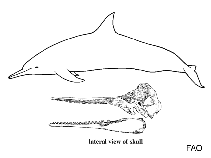Orcaella heinsohni Beasley, Robertson & Arnold, 2005
Australian snubfin dolphin| Native range | All suitable habitat | Point map | Year 2050 |

|
| This map was computer-generated and has not yet been reviewed. |
| Orcaella heinsohni AquaMaps Data sources: GBIF OBIS |
Google image | No image available for this species;
drawing shows typical species in Delphinidae.
Classification / Names Common names | Synonyms | CoL | ITIS | WoRMS
Mammalia | Cetartiodactyla | Delphinidae
Environment: milieu / climate zone / depth range / distribution range Ecology
Pelagic; depth range 0 - 200 m, usually 1 - 10 m. Tropical; 7°S - 90°S, 100°E - 180°E
Distribution Countries | FAO areas | Ecosystems | Occurrences | Introductions
Indo-Pacific: Australia and Papua New Guinea.
Length at first maturity / Size / Weight / Age
Maturity: Lm ? range ? - ? cm Max length : 270 cm TL male/unsexed; (Ref. 78832); 230 cm TL (female)
Short description Morphology
Life cycle and mating behavior Maturity | Reproduction | Spawning | Eggs | Fecundity | Larvae
Main reference
References | Coordinator | Collaborators
Beasley, I., K.M. Robertson and P. Arnold. 2005. (Ref. 78832)
IUCN Red List Status
(Ref. 130435: Version 2024-2)
CITES status (Ref. 108899)
CMS (Ref. 116361)
Threat to humans
Human uses
FAO - Fisheries: landings | FishSource |
Tools
More information
Diet composition
Food consumption
Predators
Max. ages / sizes
Length-weight rel.
Length-length rel.
Length-frequencies
Mass conversion
Abundance
Maturity
Fecundity
Spawning
Eggs
Egg development
Larvae
Internet sources
BHL | BOLD Systems | CISTI | DiscoverLife | FAO(Fisheries: ; publication : search) | Fishipedia | GenBank (genome, nucleotide) | GloBI | Gomexsi | Google Books | Google Scholar | Google | PubMed | Tree of Life | Wikipedia (Go, Search) | Zoological Record



